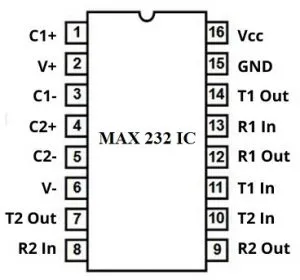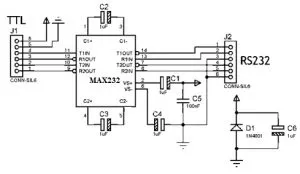MAX232 IC:Features,Applications and Types
The MAX232 integrated circuit (IC) was engineered by Maxim Integrated Products and functions as a voltage logic converter, transforming TTL logic levels into TIA or EIA-232-F levels. It serves as a crucial intermediary for communication between PCs and microcontrollers. This IC finds application in various fields including terminals, battery-operated systems, computers, modems, and more.
What is the MAX232 IC?
The MAX232 IC is extensively utilized for facilitating serial communication between microcontrollers and PCs. Its primary role is to convert TTL/CMOS logic levels to RS232 levels during the serial communication process.
Typically, a microcontroller operates within the TTL range of approximately 0 to 5V, whereas a computer adheres to RS232 standards, ranging from -25 to +25V. Hence, establishing a connection between a computer and a microcontroller necessitates the use of a MAX232 IC. For instance, if you intend to link a PIC microcontroller to a laptop's serial pin, incorporating the MAX232 IC between them is imperative.
In this context, the serial ports of laptops, such as the 9-pin port, operate using RS232 voltage logic, while the serial ports of microcontrollers, such as the Tx and Rx pins, utilize transistor logic. MAX232 IC equivalents for RS232 conversion include RS232 modules, MC1488, RS232 adapter cables, and FT232RL.
IC Structure
The MAX232 IC comprises three primary components depicted in the accompanying diagram. It operates using a 5-volt power supply, making it compatible with nearly all embedded systems. The initial block is the voltage doubler, employing a switched capacitor technique within the IC to double the voltage.
Following voltage doubling, the subsequent block converts the voltage to +10 and -10. The final component consists of two transmitters and two receivers responsible for voltage level conversion.
MAX232 IC Variants
There are two variations of MAX232 ICs, namely MAX232N and MAX232D.
In the MAX232N IC, the "N" denotes the PDIP package style, which is straightforward to market and is the most commonly employed package style.
On the other hand, the MAX232D IC features the SOIC package denoted by the "D", which is challenging to market but demands skilled expertise for proper utilization.
MAX232 IC Pinout
The MAX232 IC is comprised of 16 pins, with each pin delineated as follows. This IC necessitates the use of four external capacitors to ensure its proper functionality. These four capacitors typically fall within the range of 8 to 10.

MAX232 IC Pin Functions
The MAX232 IC features 16 pins, each serving a distinct purpose as outlined below.
Pin 1 (C1+): This pin is where the positive terminal of a capacitor is connected.
Pin 2 (Vs+): Grounding the negative leg, this pin connects to the positive leg of a capacitor.
Pin 3 (C1-): The negative terminal of the capacitor connects to this pin, while the positive terminal is linked to Pin 1.
Pin 4 (C2+): This pin connects to the positive terminal of another capacitor.
Pin 5 (C2-): The negative terminal of the capacitor connects here, while the positive terminal links to Pin 4.
Pin 6 (Vs-): Grounding the negative terminal, this pin supplies 5 volts to the positive terminal of the capacitor.
Pin 7 (T2OUT): Providing the converted TTL signal as RS-232, this pin receives TTL signals from the microcontroller's T2IN pin, and it's connected to Pin 2 of a DB-9 port, typically the RxD pin of your computer.
Pin 8 (R2IN): This pin accepts RS-232 input signals and delivers converted TTL signals at the R2OUT pin. It connects to Pin 3 of a DB-9 port, typically the TxD pin.
Pin 9 (R2OUT): Providing TTL-formatted signals, this pin receives signals from the computer's R1IN pin. Connect it to the RxD pin of your TTL module to receive signals.
Pin 10 (T2IN): Receiving transmitted signals from the microcontroller, this pin delivers converted RS-232 signals at the T2OUT pin. It connects to the microcontroller's serial port TxD pin and can be linked to the TxD pin of your module.
Pin 11 (T1IN): This pin functions identically to T2IN.
Pin 12 (R1OUT): This pin functions similarly to R2OUT.
Pin 13 (R1IN): This pin operates in a manner akin to R2IN.
Pin 14 (T1OUT): This pin operates similarly to T2OUT.
Pin 15 (GND): Serving as the ground pin.
Pin 16 (VCC): This pin serves as the voltage supply pin, receiving 5V.
MAX232 IC Operation
The primary role of the MAX232 IC is to convert TTL logic level signals into their corresponding RS-232C level signals, and vice versa. This conversion capability proves invaluable when establishing data transfer connections between two devices.
Consider this scenario: most microcontrollers operate using TTL logic waveforms. Equipped with a UART, these microcontrollers can transmit and receive serial data, operating exclusively within the TTL logic level domain. Conversely, typical PCs utilize RS-232 waveform levels for data transmission and reception.
When transmitting data from a microcontroller to a personal computer, it becomes necessary to convert the data from TTL to RS-232 levels. The MAX232 IC serves as the optimal solution for this conversion task. Operating at speeds of up to 120 Kbits per second, the MAX232 IC features two receiver and two driver channels.
Its transmission range spans from 12 to 15 meters, making it suitable for various applications including terminals, modems, computers, scanners, printers, and fax machines.
Specifications
The MAX232 IC boasts the following key specifications:
Available in 16-pin SOIC, PDIP, and SO packages
Straightforward Setup and Initialization
Operational Speed: 120 kbit/s
Operating Current: 8mA
Input Levels: ±30V
Facilitates conversion from TTL or CMOS to RS232
Supports two conversions simultaneously, featuring dual drivers and receivers
Effortlessly converts TIA/EIA 32 to CMOS/TTL with a simple 5V power supply
Integration of a 1.0uF capacitor addresses power decimation concerns
Voltage levels may vary among RS232 devices in certain scenarios
Maximum operating temperature: 150°C
Packages, Dimensions & Specifications
The MAX232 IC is available in the following packages:
SOIC (16)
SOP (16)
PDIP (16)
Package dimensions for the MAX232 IC are as follows:
SOIC (16) package: 9.90 x 3.91 mm
PDIP (16) package: 19.03 x 6.35 mm
SOP (16) package: 10.03 x 5.3 mm
The ratings of the MAX232 IC encompass its current, voltage, and power requirements, providing insights into its operational parameters:
Input voltage range: -0.3V to 6V
Output voltage range: 0.3V to +0.3V
Operating temperature: 150°C
MAX232 IC Schematic
Below is the circuit diagram illustrating the application of the MAX232 IC for RS232-TTL level shifting. This configuration is particularly suitable for interfacing with microcontrollers, facilitating seamless signal level transitions between TTL and RS232.
Constructed around the MAX232 IC and augmented with four external capacitors to internally generate the required voltage, this circuit offers versatility. While MAX232 IC clones with similar functionalities exist, they are typically cost-effective and interchangeable without complications.

In scenarios where TTL signals from modern microcontrollers operate at lower voltages, substituting the MAX232 IC with the MAX3232 becomes imperative, given its compatibility with voltages starting from approximately 3V. Alternatively, if the MAX3232 is unavailable, it may be feasible to employ a standard MAX232 with a lower voltage supply, although this might lead to outputs deviating from the RS232 standard specifications.
The recommended maximum transmission distance is approximately 10 meters at 115200 bps. For longer distances, alternative protocols like RS485, which employ differential signaling to mitigate noise interference, can be employed, albeit requiring additional wiring.
Where to Utilize the MAX232 IC / Applications
The MAX232 IC finds application in various areas, including:
Interfacing microcontrollers with PCs
Computers
Converting TTL or CMOS logic to RS232
Modems
Terminals
Incorporation into RS232 cables
Portable computing devices
Interface transactions
RS232 systems powered by batteries
Low-power modes
In essence, the MAX232 IC serves as a crucial component in RS232 communication systems, facilitating voltage level conversions necessary to ensure compatibility between TTL devices and PC serial ports. Acting as a hardware converter layer, this chip enables seamless communication between two disparate systems. With its versatility, the MAX232 IC proves invaluable in resolving voltage level signal conversion challenges. As for your question, RS232 refers to a standard for serial communication transmission of data, employing specific voltage levels for signaling between devices.
What is an Electric Motor? Explain its Types
What Passive Band Pass Filter is and How It works
Understanding the Importance of Industrial Supplies
What are Flat Flex Ribbon Jumpers(FFRJs)? All Explained
What is an Industrial Automation Control System? Fully Explained
Internal vs External Power Supplies: Pick the Right One for You!
Pockels Cells: Features, Principle & Applications
What 74LS08 AND Gate IC is and How It Works
What is Embedded Systems: Features, Working, Applications?
Isolator vs Circuit Breaker: What's the Differences?
Computer Hardware: Definition and Components (Guide)










